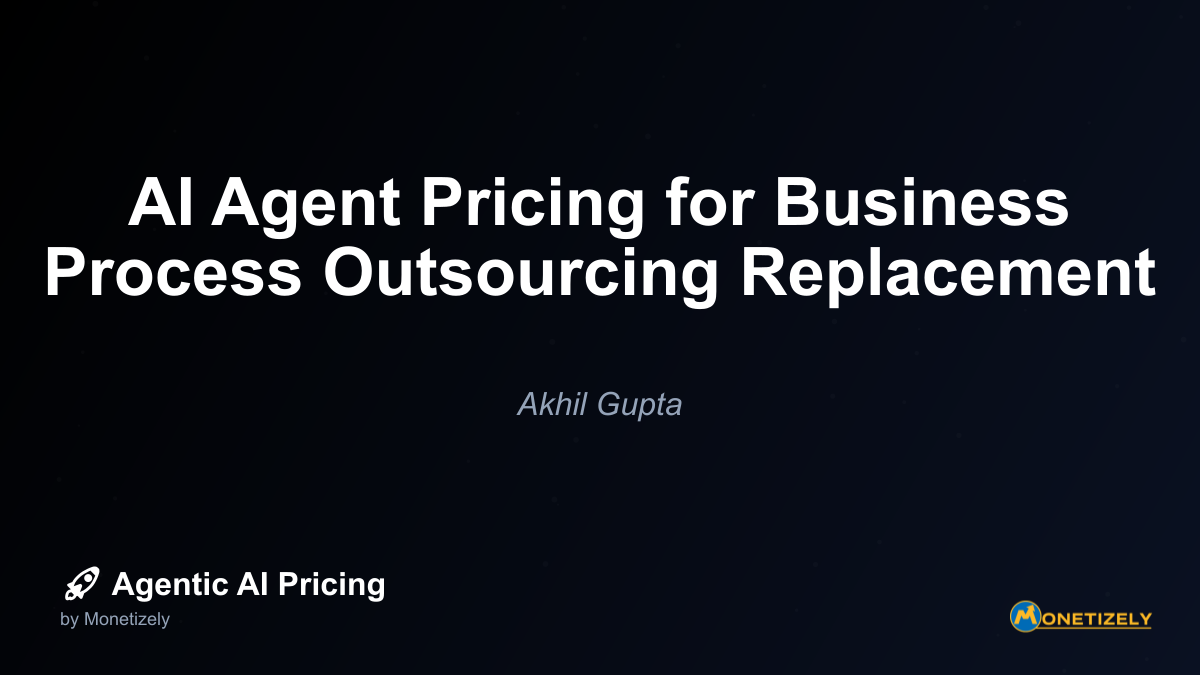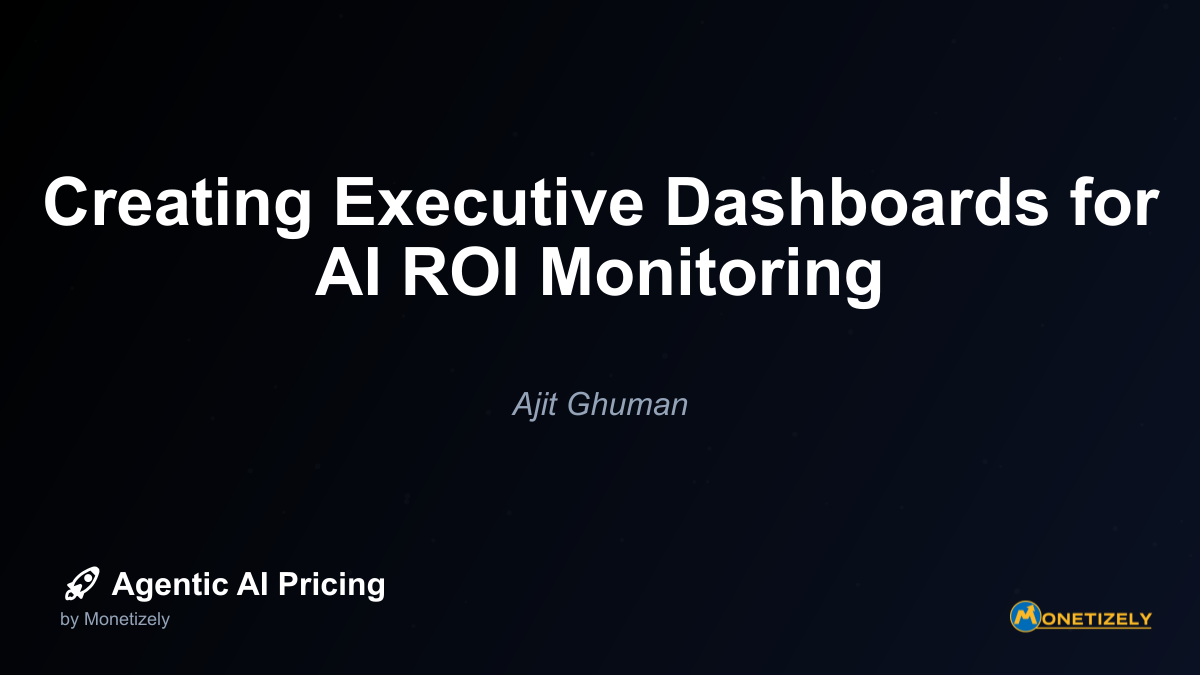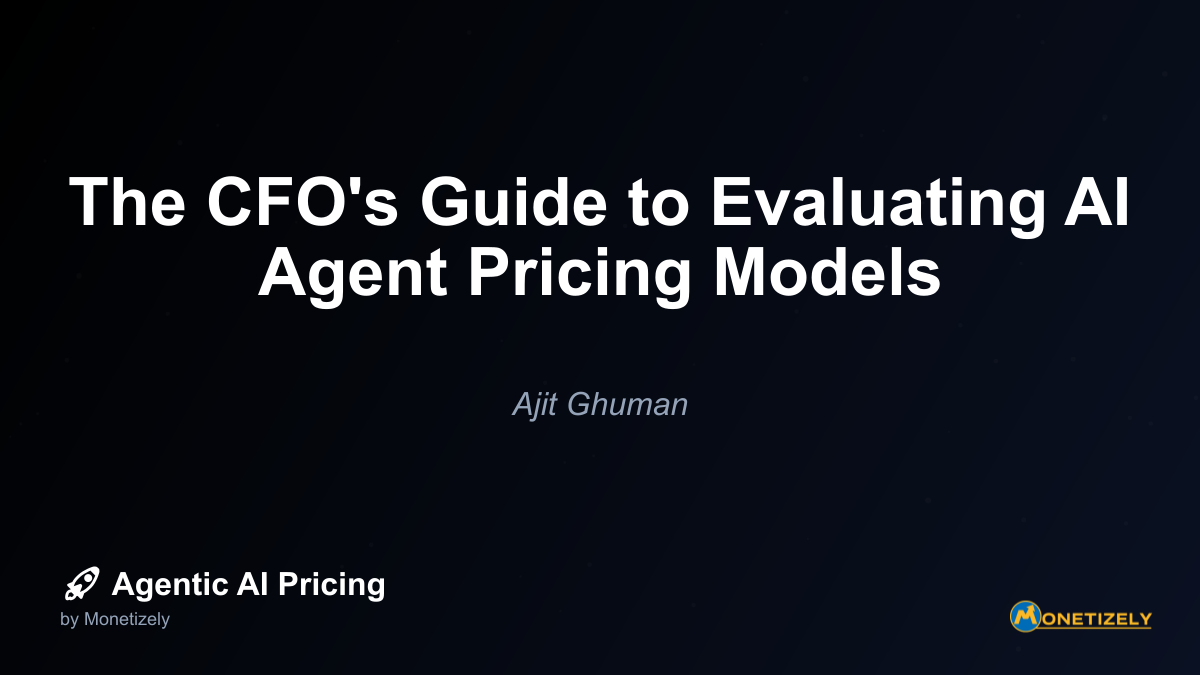· Akhil Gupta · ROI and Value · 9 min read
Linking AI Outcomes to Revenue Growth.
AI and SaaS Pricing Masterclass
Learn the art of strategic pricing directly from industry experts. Our comprehensive course provides frameworks and methodologies for optimizing your pricing strategy in the evolving AI landscape. Earn a professional certification that can be imported directly to your LinkedIn profile.

In today’s competitive business landscape, organizations are increasingly turning to AI agents to drive efficiency, enhance customer experiences, and ultimately boost revenue. However, a critical challenge remains: how do you accurately measure and attribute revenue growth to your AI initiatives? This question isn’t merely academic—it’s fundamental to justifying AI investments and optimizing deployment strategies.
The connection between AI outcomes and revenue metrics often remains nebulous, with many organizations struggling to draw clear lines between their AI implementations and bottom-line results. This disconnect can undermine confidence in AI investments and hinder further adoption, despite the technology’s transformative potential.
This article explores practical approaches to linking AI agent outcomes directly to revenue metrics, providing frameworks for attribution and measurement that can help organizations clearly demonstrate the value of their AI initiatives.
The Attribution Challenge in AI Investments
Attributing revenue growth to AI implementations presents unique challenges compared to traditional technology investments. Unlike a straightforward sales tool or marketing campaign with clear conversion paths, AI agents often influence revenue through multiple touchpoints and indirect mechanisms.
Why AI Attribution Is Difficult
Several factors contribute to the complexity of AI attribution:
Multiple touchpoints: AI agents typically interact with customers across various stages of their journey, making it difficult to isolate their specific contribution.
Indirect influence: Many AI implementations enhance processes that indirectly affect revenue, such as improving customer satisfaction or streamlining operations.
Complementary effects: AI often works alongside human teams, creating synergistic effects that are difficult to separate.
Time lag: The full revenue impact of AI may not materialize immediately, requiring longitudinal analysis to capture.
Counterfactual uncertainty: It’s challenging to determine what would have happened without the AI intervention.
Despite these challenges, developing a robust attribution framework is essential for validating AI investments and guiding future deployment decisions.
Framework for Linking AI Outcomes to Revenue Metrics
A comprehensive approach to AI attribution requires a methodical framework that connects specific AI actions to measurable revenue outcomes. Here’s a structured approach:
1. Define Clear Revenue Metrics
Before attempting attribution, organizations must clearly define the revenue metrics they aim to influence:
- Direct revenue generation: New sales, upsells, cross-sells
- Revenue retention: Reduced churn, increased renewal rates
- Revenue efficiency: Decreased cost of acquisition, increased lifetime value
- Revenue acceleration: Shortened sales cycles, faster time-to-value
Each AI implementation should target one or more of these revenue categories with explicit goals.
2. Establish AI Outcome Indicators
Next, identify the specific outcomes your AI agent produces that could logically connect to revenue metrics:
- Engagement metrics: Conversation duration, user satisfaction scores
- Process metrics: Time savings, error reduction, completion rates
- Decision metrics: Recommendations made, insights generated
- Behavioral metrics: Changes in customer or employee actions
These outcome indicators serve as the intermediate variables between AI activity and revenue impact.
3. Map Causal Pathways
Create explicit causal models that map how AI outcomes lead to revenue changes. For example:
- AI sales assistant → More qualified leads identified → Higher conversion rate → Increased new sales
- Support AI → Faster issue resolution → Improved customer satisfaction → Higher retention rates → Preserved revenue
These pathways should be logical, defensible, and ideally backed by existing research or industry benchmarks.
4. Implement Measurement Mechanisms
Deploy specific measurement tools and methodologies to track both the AI outcomes and their revenue effects:
- A/B testing: Compare revenue metrics between groups with and without AI assistance
- Time-series analysis: Measure changes in revenue metrics before and after AI implementation
- Multivariate regression: Control for other factors while isolating AI’s contribution
- Attribution modeling: Apply weighted models to distribute credit for revenue outcomes
- Customer journey analysis: Track how AI interactions influence the path to purchase
The right measurement approach depends on your specific AI use case and available data infrastructure.
Case Studies: AI Attribution in Action
Sales AI Attribution
A B2B software company implemented an AI sales assistant that engaged with website visitors, qualified leads, and scheduled demos with sales representatives. To attribute revenue impact, they:
- Tagged all leads that interacted with the AI agent
- Tracked these leads through the sales pipeline
- Compared conversion rates and deal sizes with non-AI-assisted leads
- Calculated the incremental revenue by multiplying the increase in conversion rate by the average deal size
The analysis revealed that AI-assisted leads converted 23% more frequently and had 11% higher average contract values, directly attributing $2.3 million in incremental annual revenue to the AI implementation.
Customer Support AI Attribution
A subscription-based service deployed an AI support agent to handle customer inquiries and resolve issues. To link this to revenue retention, they:
- Measured customer satisfaction scores for AI-handled vs. human-handled interactions
- Analyzed the correlation between satisfaction scores and renewal rates
- Tracked cohorts of customers with high AI engagement versus low engagement
- Calculated the churn reduction among high-AI-engagement customers
The data showed that customers who regularly engaged with the AI support system had 18% lower churn rates, translating to approximately $4.1 million in preserved annual recurring revenue.
Specialized Attribution Methods for Different AI Agent Types
Different types of AI agents require tailored attribution approaches based on their function and how they interact with revenue-generating processes.
Attributing Revenue to Conversational AI Agents
Conversational AI agents like chatbots and virtual assistants require specific attribution methods:
- Conversation funnel analysis: Track conversion rates at each stage of AI-led conversations
- Intent fulfillment tracking: Measure how effectively the AI resolves high-value customer intents
- Handoff success rates: Analyze revenue outcomes from conversations transferred from AI to humans
- Sentiment progression: Monitor how customer sentiment evolves during AI interactions and correlate with purchase behavior
For example, a retail company might attribute revenue by tracking customers who engaged with their AI shopping assistant and subsequently made purchases, applying a time-decay model to account for other influences between the interaction and conversion.
Attributing Revenue to AI Decision Support Systems
For AI systems that support human decision-makers (like AI-powered analytics dashboards or recommendation engines), attribution methods include:
- Decision adoption rates: Track how often human agents follow AI recommendations
- Decision outcome comparison: Compare revenue outcomes when AI recommendations are followed versus ignored
- Counterfactual analysis: Model what decisions would likely have been made without AI input
A financial services firm using an AI-powered investment recommendation system might track the performance differential between portfolios managed with and without AI assistance, directly quantifying the value added.
Attributing Revenue to Autonomous AI Agents
For fully autonomous AI agents that operate with minimal human oversight:
- Direct output measurement: Quantify the immediate outputs (e.g., tasks completed, decisions made)
- Resource reallocation value: Measure the revenue impact of human resources redirected to higher-value activities
- Error reduction value: Calculate the revenue preserved by avoiding costly mistakes
For instance, an e-commerce company using autonomous AI for inventory management might attribute revenue by calculating the reduction in stockouts and overstock situations, translating these into preserved sales and reduced carrying costs.
Overcoming Common Attribution Challenges
Even with robust frameworks, several challenges remain in linking AI outcomes to revenue. Here are strategies to address common obstacles:
Challenge 1: Isolating AI’s Contribution in Complex Systems
Solution: Implement controlled experiments where possible, using techniques like:
- Gradual rollouts where some regions or segments use the AI while others don’t
- Periodic AI “blackouts” in select areas to create natural control groups
- Propensity score matching to create comparable cohorts for analysis
Challenge 2: Accounting for Time Lags
Solution: Develop longitudinal measurement approaches:
- Use time-series models that incorporate appropriate lag periods
- Implement cohort analysis to track groups over extended periods
- Apply attribution windows based on typical customer journey timelines
Challenge 3: Quantifying Indirect Benefits
Solution: Create proxy metrics that connect to revenue:
- Map employee time savings to either cost reduction or revenue-generating activities
- Translate customer satisfaction improvements to predicted lifetime value increases
- Convert process improvements to efficiency gains that scale with revenue
Challenge 4: Addressing Multiple Touchpoints
Solution: Implement sophisticated attribution models:
- First-touch or last-touch attribution for simpler scenarios
- Linear, time-decay, or U-shaped models for more complex journeys
- Algorithmic attribution using machine learning to dynamically assign credit
Building Your AI Revenue Attribution Roadmap
Developing a comprehensive attribution system takes time. Here’s a phased approach to building your capabilities:
Phase 1: Establish Baseline Metrics (1-3 Months)
- Document current revenue metrics in detail
- Map existing processes and identify AI intervention points
- Establish data collection mechanisms for AI outcomes
- Create hypotheses about expected revenue impacts
Phase 2: Implement Initial Attribution Models (3-6 Months)
- Deploy simple attribution models based on direct correlations
- Begin controlled experiments where possible
- Develop dashboards to visualize relationships between AI metrics and revenue
- Collect qualitative feedback from stakeholders to refine attribution approaches
Phase 3: Refine and Scale (6-12 Months)
- Implement more sophisticated attribution models
- Expand measurement to capture indirect and long-term effects
- Integrate AI attribution with broader business intelligence systems
- Develop predictive models for future AI investments
Phase 4: Optimize and Innovate (Ongoing)
- Continuously refine attribution models based on accumulated data
- Apply learnings to optimize AI deployment strategies
- Use attribution insights to guide future AI investments
- Develop organization-specific attribution best practices
Practical Implementation Tips
To successfully implement AI revenue attribution in your organization:
Data Infrastructure Requirements
Ensure your technical foundation supports attribution by:
- Implementing unique identifiers to track customers across touchpoints
- Establishing data pipelines that connect AI interactions with revenue systems
- Creating data warehousing solutions that support longitudinal analysis
- Deploying analytics tools capable of complex attribution modeling
Organizational Alignment
Build cross-functional support for attribution efforts:
- Align sales, marketing, customer success, and AI teams on attribution goals
- Establish shared KPIs that bridge AI outcomes and revenue metrics
- Create regular reporting cadences to review attribution findings
- Develop incentive structures that reward accurate attribution practices
Continuous Improvement
Treat attribution as an evolving capability:
- Regularly audit attribution models against actual outcomes
- Update attribution approaches as AI capabilities evolve
- Benchmark attribution practices against industry standards
- Incorporate stakeholder feedback to refine attribution methods
Conclusion: From Attribution to Strategic Advantage
Linking AI outcomes to revenue growth isn’t merely an accounting exercise—it’s a strategic capability that can fundamentally transform how organizations deploy and optimize their AI investments.
Organizations that master AI attribution gain several competitive advantages:
- More efficient resource allocation: Directing investments toward AI initiatives with proven revenue impact
- Accelerated AI adoption: Building internal support through clear demonstration of value
- Optimized AI implementations: Refining AI systems based on their specific revenue contributions
- Stronger competitive positioning: Leveraging data-driven insights to outperform less sophisticated competitors
The journey to robust AI attribution is challenging but essential. By methodically connecting AI outcomes to revenue metrics, organizations can move beyond faith-based AI investments toward a disciplined approach that maximizes return on AI initiatives.
As AI becomes increasingly central to business operations, the ability to quantify its revenue impact will separate leaders from followers. Organizations that develop this capability now will be positioned to make smarter AI investments, optimize their implementations, and ultimately capture greater value from this transformative technology.
Co-Founder & COO
Akhil is an Engineering leader with over 16+ years of experience in building, managing and scaling web-scale, high throughput enterprise applications and teams. He has worked with and led technology teams at FabAlley, BuildSupply and Healthians. He is a graduate from Delhi College of Engineering and UC Berkeley certified CTO.
Pricing Strategy Audit
Let our experts analyze your current pricing strategy and identify opportunities for improvement. Our data-driven assessment will help you unlock untapped revenue potential and optimize your AI pricing approach.




